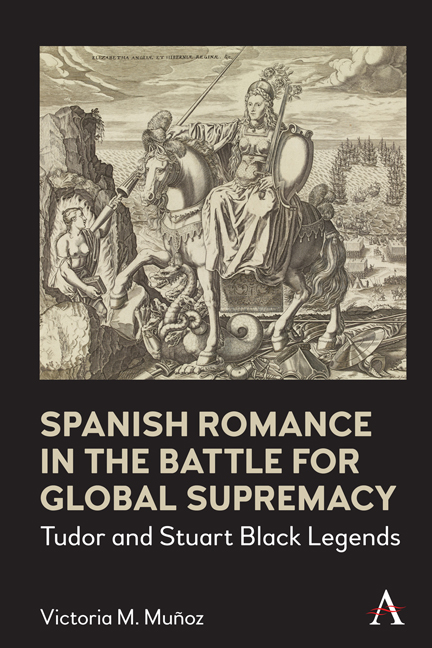Book contents
- Frontmatter
- Contents
- List of Figures
- Acknowledgments
- Prologue: Translating Romance, Empire, and Spain
- Chapter One “Books of the Brave” English: Spanish Tales of Love and Arms in Translation
- Chapter Two Dream Visions and Competing Dreams: Rewriting the Spanish Model in America
- Chapter Three Sun Kings and Moon Queens: The Courting and Uncourting of Spain
- Chapter Four Signs of England: Redcrosse Crosses the Ancient Boundary
- Chapter Five Believing Bottom’s Dream: Rationalizing Exploration from America to Australia
- Chapter Six Unruly Readers: Anti-Spanish Sentiment and the Feminizing of Romance
- Epilogue: Spanish Literature in England before Don Quixote
- Appendix I English Readership of Spanish Romance, By the Numbers
- Selected Bibliography
- Index
Chapter Two - Dream Visions and Competing Dreams: Rewriting the Spanish Model in America
Published online by Cambridge University Press: 22 February 2022
- Frontmatter
- Contents
- List of Figures
- Acknowledgments
- Prologue: Translating Romance, Empire, and Spain
- Chapter One “Books of the Brave” English: Spanish Tales of Love and Arms in Translation
- Chapter Two Dream Visions and Competing Dreams: Rewriting the Spanish Model in America
- Chapter Three Sun Kings and Moon Queens: The Courting and Uncourting of Spain
- Chapter Four Signs of England: Redcrosse Crosses the Ancient Boundary
- Chapter Five Believing Bottom’s Dream: Rationalizing Exploration from America to Australia
- Chapter Six Unruly Readers: Anti-Spanish Sentiment and the Feminizing of Romance
- Epilogue: Spanish Literature in England before Don Quixote
- Appendix I English Readership of Spanish Romance, By the Numbers
- Selected Bibliography
- Index
Summary
On November 8, 1519, a small retinue of Spanish soldiers and native Tlaxcalan warriors led by Hernán Cortés entered the Aztec capital city, Tenochtitlán. The foreigners had been searching for this wondrous city since Don Diego de Ordaz and his companions had a glimpse of it a month earlier after enduring the volcanic ascent of Popocatépetl. From this brave summit, the conquerors first beheld the incomparably rich valley of México, intersected by a vast lake system, and at the center, the famed Aztec capital, with its white towers and pyramidal teocalli rising from their walled enclosures, reflecting the rays of the sun on their stucco walls. To the European observers, the sight seemed analogous to that beheld by eleventh-century Christian Crusaders who marched on Jerusalem. The truth of the event was far different. Cortés brokered a fateful agreement with the Mexica Emperor Moctezuma II, who later found himself hostage to the Spanish soldiers and was killed in the ensuing conflicts (June 29, 1520). Moctezuma's attitude toward the white men had initially been guided by the fact that their ships appeared in the year in which the Aztec god, Topiltzin-Quetzalcoatl, was supposed to make his appearance. Initially, at least, Moctezuma was unsure as to who these men were.
Less than two years later, Cortés and his compatriots had defeated Moctezuma's son-in-law, the final Emperor Cuauhtémoc (ruled 1520–1521), and with him, the Aztec Empire fell. Accounts differ wildly on the facts of the conquest, with some expressing sympathy for the late Moctezuma, apparently double-crossed by Cortés, and others vilifying him as a traitor to his own people. The net result was the destruction of the Mexica civilization, which became famous in Europe for both its incredible richness and its tragic demise. This chapter tracks that powerful legacy through Spanish histories and romances and into English drama, where it served to rationalize England's own colonial interventions in America.
México in the Renaissance Imagination
In his correspondence with Holy Roman Emperor Charles V, Cortés emphasized the supreme cultural and economic wealth of the Aztec Empire, particularly observing México's great causeways and modern aqueducts—easily comparable to those of ancient Rome—and its bustling marketplace and trade economy—not unlike contemporary Venice. These letters conveyed the simultaneous cultural richness and pagan Otherness of the Mexica peoples.
- Type
- Chapter
- Information
- Spanish Romance in the Battle for Global SupremacyTudor and Stuart Black Legends, pp. 39 - 66Publisher: Anthem PressPrint publication year: 2021



